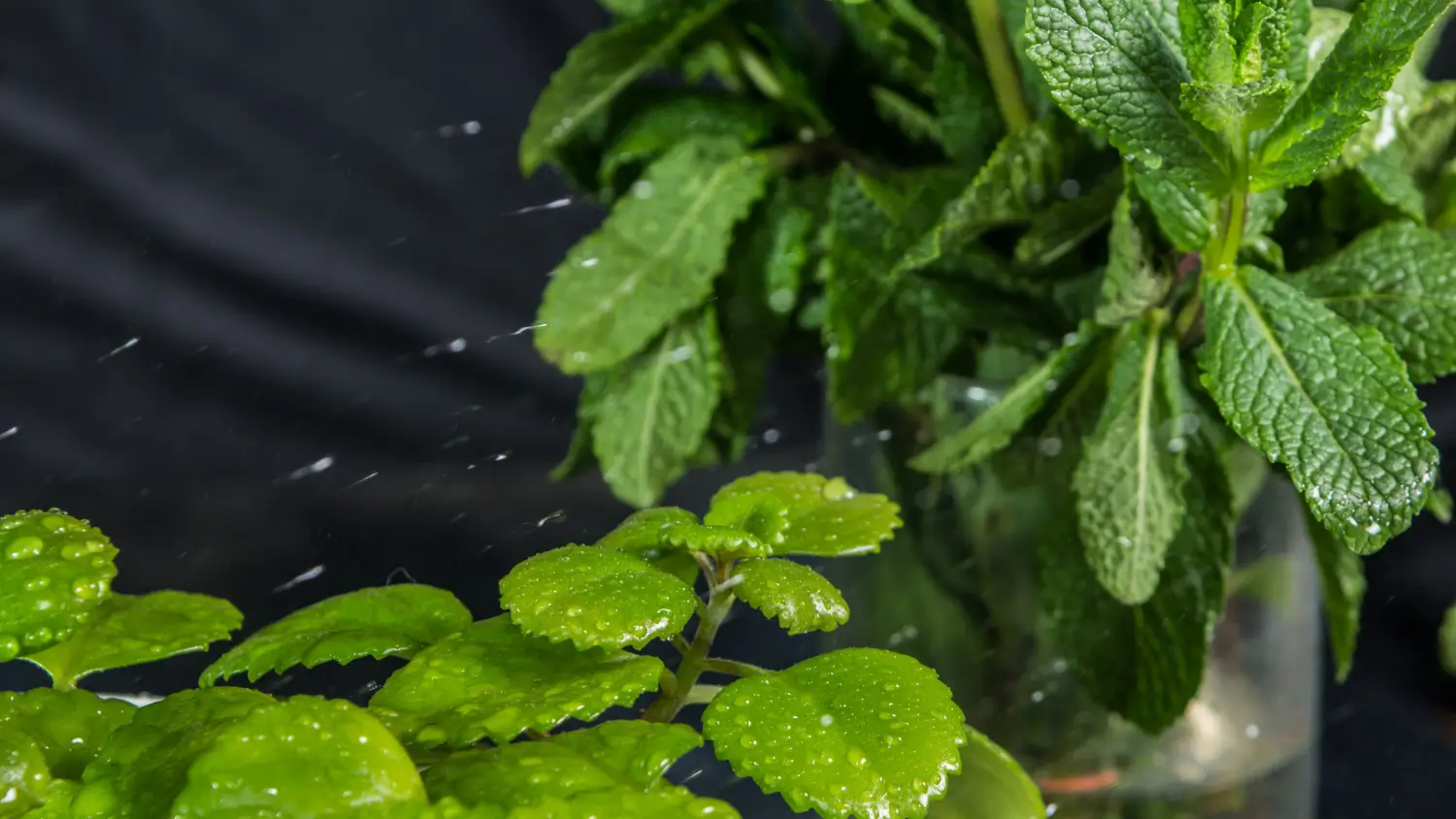
August 24, 2025

Mint is a necessary, fragrant herb that you can find in any kitchen, medicine chest, and garden across the globe. Its pungent aroma and taste are used in a variety of dishes, including teas, salads, and pastries. It is also one of nature’s marvels when it comes to relieving stomach problems and headaches. It lends a pretty appearance to the garden. Over 70% of home gardeners plant mint as it is low-maintenance and grows easily in all conditions.
Despite being hardy, mint is susceptible to pests and diseases. Insects like aphids and spider mites, as well as problems like powdery mildew, can damage mint plants, altering their taste and smell, as well as making them less healthy. Natural and organic methods are important because they help protect the mint without harming the environment.
Growcycle is serving a key mission of teaching gardeners to use natural, environmentally safe methods for dealing with pests and disease. This is what helps mint plants be healthy, fresh, and productive. Gardeners can also learn to develop a habitat that discourages pests from remaining, thereby decreasing dependence on chemical treatments.
Mint is in the Lamiaceae family, which also has many fragrant herbs like rosemary, basil, and thyme. It has been grown for hundreds of years, and records show that people in ancient Egypt, Greece, and Rome used it in food and medicine.
There are many kinds of mint, and each one smells and tastes different. Here are some of the most common types:
The mint plant is most appreciated for its array of useful applications:
Mint is a fast-growing perennial herb that spreads rapidly through underground runners (rhizomes). Because of its aggressive growth, it can take over garden beds if not controlled. Many gardeners prefer to grow mint in containers to prevent it from spreading uncontrollably. It thrives in:
Many kinds of bugs and mites can hurt or upset mint leaves, which can slow their growth and change the taste or health of the plant. Knowing about these pests early on and the damage they do can help gardeners take early steps to keep them away.
Aphids are small, soft-bodied bugs that live on the undersides of leaves and stems. They can be green, black, yellow, or brown because they eat plant sap, the leaves and stems become weak and bent. Also, they give off a sticky sap that mold loves and that ants love. As many as several generations of aphids can be born in a single season. They move quickly from one plant to another, especially when it's warm outside.
It can be hard to see spider mites without a magnifying glass because they are so small. They are usually red or yellow spider mites. If they get into plant cells, they will make the leaves look spotty or silvery. The leaves often dry out and break when they get infested. Fine webs on the leaves will show that there are spider mites. Most of these pests like it when it's hot and dry.
Whiteflies are tiny, white bugs that look like moths and gather on the undersides of leaves. When they are startled, they come up in a cloud and drink the sap from mint leaves. This makes the leaves turn yellow, wilt, and grow slowly. Like aphids, they also make saliva, on which mold can grow. They do best when it's hot outside and breed quickly, which makes getting rid of them from your home hard.
The best way to get rid of pests is to keep them from coming in the first place. Gardeners should keep an eye out for these signs:
As pests feed on mint plants, they also tend to weaken them, and the plant is unable to produce those flavorful aromatic leaves. Some key effects include:
Reduced Yield: Infected mint plants may produce fewer leaves, which means some harvests may be fruitless.
Fungal, bacterial, and viral infections are mint's most common issues. Many of these diseases thrive in humid or overcrowded conditions, making prevention key to maintaining healthy plants.
Powdery mildew is one of the most prevalent fungal diseases in mint plantings. It looks like white powdery areas on the leaves and stems. The infection can spread throughout the entire plant as it develops, causing the structure to weaken and the leaves to lose quality. The ailment is spread by fungal spores that favor hot, dusty conditions with scant air movement.
Rust is a fungal infection and creates small greenish brown pustules under the leaves of mint, which may also turn yellow. The affected leaves dry out and are shed as the spread of infection intensifies. Rust is known to spread very quickly when moist, particularly when plants are too close together.
The cause of leaf spot is dark brown or black spots that appear on the mint leaves, which frequently have yellow halos surrounding them. This condition is typically caused by fungi that grow in extremely moist conditions. The plant with leaf spot becomes weaker and is more prone to further infections; the leaves are of inferior quality.
Leaf blight is a bacterial disease that results in brownish streaking, water-soaked blotches, and wilting of mint leaves. Plants that become infected quickly decline, primarily because the bacteria destroy tissues and cells associated with nutrient and water transport. This makes infected mint plants more vulnerable to further stress and secondary infections.
Less frequently, mint plants are severely affected by viral infections. Symptoms of viral infection can be stunted growth, twisted foliage, mottled patterns, or yellow streaking on the leaves. These infections are commonly vectored by insects, such as aphids and thrips, that pick up the virus from one plant to another.
Managing pests and diseases naturally involves using methods that are good for the environment and the plants. Here are the basic principles of natural pest and disease management:
Organic methods use natural materials and methods that are good for the environment. Gardeners, for instance, keep plants safe by using compost, natural ways to get rid of bugs, and healthy dirt.
Eco-friendly methods are safer for the environment, people, and animals. They avoid polluting the soil, air, and water with harmful chemicals. Organic methods also support biodiversity and protect helpful insects like bees and ladybugs.
IPM is a way to get rid of pests and diseases that uses a variety of techniques.
The first step in IPM is to stop problems before they happen. Getting rid of pests and diseases before they happen is better. Pick strong plant types, take care of them, and keep the garden clean to avoid problems.
A healthy garden with many types of plants and insects helps control pests naturally. For example, bees and butterflies help pollinate plants, while insects like ladybugs eat harmful pests. Healthy soil with good microorganisms also helps plants fight diseases.
A garden with many different types of plants and animals helps prevent pests from taking over. Different plants can confuse pests and make it harder for them to find their favorite plants. Having a variety of species in the garden also attracts natural predators, which keep pests in check.
Organic pest control strategies for mint focus on using natural methods to manage pests without relying on harmful chemicals. These strategies promote a healthier garden ecosystem, protect beneficial insects, and ensure that the mint plants remain safe for consumption.
Beneficial organisms are natural predators that effectively target common mint pests like aphids, spider mites, and whiteflies.
Companion Planting: Companion plants invite the good bugs while deterring pesky pests that munch on your mint. Basil, marigold, and lavender can do this, for example, to aphids, mosquitoes, and other things that bug mint.
Mint plants can be kept healthy by naturally controlling illnesses and focusing on preventing them in the first place. Here is a list of some of the most important natural ways to keep mint plants from getting diseases.
Rotation: Planting mint with other plants in different soil spots every year helps lower the number of pathogens in planting beds.
Natural pest and disease management for mint ensures the plant thrives without harming the environment. Gardeners can protect their mint plants successfully by natural means, like releasing beneficial insects, using natural sprays and following proper growing guidelines. These practices deter pests and disease and foster a healthier, more diverse garden ecosystem. Check Growcyle for details on the best natural home gardening pest and disease solutions.
Disclaimer: This material is for informational purposes only and should not be relied on for legal, medical, financial, or any other form of professional advice.
To cure plant diseases naturally, gardeners can use organic treatments, such as baking soda spray for fungal issues and garlic or chamomile teas for their antifungal properties. They can also ensure proper watering and air circulation to prevent disease.
The best natural pest control depends on the pests, but common methods include introducing beneficial insects like ladybugs, using neem oil or insecticidal soap, and practicing proper garden hygiene.
Pest and disease management includes various techniques, such as using natural predators, organic treatments, and proper garden care, to maintain healthy plants without harming the environment.